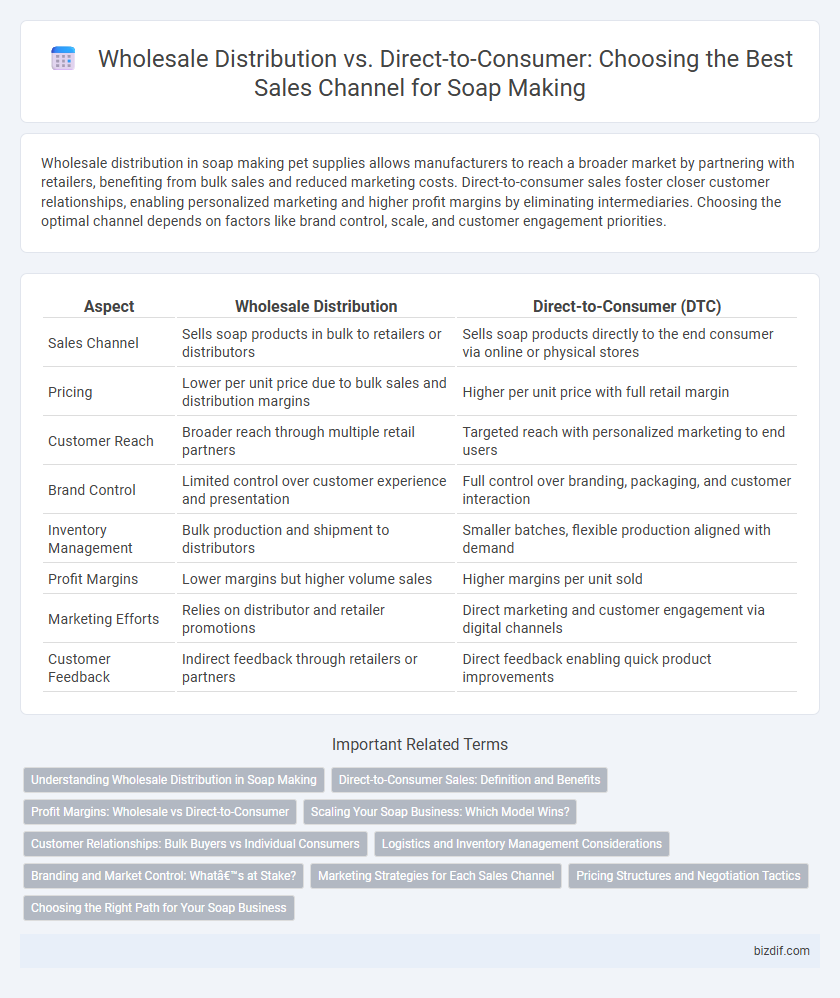Wholesale distribution in soap making pet supplies allows manufacturers to reach a broader market by partnering with retailers, benefiting from bulk sales and reduced marketing costs. Direct-to-consumer sales foster closer customer relationships, enabling personalized marketing and higher profit margins by eliminating intermediaries. Choosing the optimal channel depends on factors like brand control, scale, and customer engagement priorities.
Table of Comparison
| Aspect | Wholesale Distribution | Direct-to-Consumer (DTC) |
|---|---|---|
| Sales Channel | Sells soap products in bulk to retailers or distributors | Sells soap products directly to the end consumer via online or physical stores |
| Pricing | Lower per unit price due to bulk sales and distribution margins | Higher per unit price with full retail margin |
| Customer Reach | Broader reach through multiple retail partners | Targeted reach with personalized marketing to end users |
| Brand Control | Limited control over customer experience and presentation | Full control over branding, packaging, and customer interaction |
| Inventory Management | Bulk production and shipment to distributors | Smaller batches, flexible production aligned with demand |
| Profit Margins | Lower margins but higher volume sales | Higher margins per unit sold |
| Marketing Efforts | Relies on distributor and retailer promotions | Direct marketing and customer engagement via digital channels |
| Customer Feedback | Indirect feedback through retailers or partners | Direct feedback enabling quick product improvements |
Understanding Wholesale Distribution in Soap Making
Wholesale distribution in soap making involves selling large quantities of soap products to retailers or businesses, enabling manufacturers to reach a broader market without handling individual customer orders. This channel typically requires building relationships with distributors who manage logistics, inventory, and bulk sales, facilitating efficient supply chain management. Understanding wholesale distribution helps soap makers scale production, reduce per-unit costs, and focus on product development rather than direct sales.
Direct-to-Consumer Sales: Definition and Benefits
Direct-to-consumer (DTC) sales in soap making involve selling products directly to customers without intermediaries, ensuring fresher, customized goods and higher profit margins. This model enhances brand control, allows for personalized marketing strategies, and fosters stronger customer relationships through direct feedback and engagement. Soap makers benefit from better inventory management and increased flexibility by bypassing wholesale distributors.
Profit Margins: Wholesale vs Direct-to-Consumer
Wholesale distribution in soap making typically offers lower profit margins, often ranging between 20% to 35%, because products are sold in bulk at discounted rates to retailers. Direct-to-consumer sales enable soap makers to capture higher profit margins, frequently between 50% to 70%, by eliminating intermediaries and setting retail prices. Higher margins from direct sales support brand control and customer loyalty, while wholesale offers volume sales with reduced margin per unit.
Scaling Your Soap Business: Which Model Wins?
Wholesale distribution enables soap makers to rapidly expand market reach by partnering with retailers, offering bulk orders that streamline inventory management and increase brand visibility in various regions. Direct-to-consumer sales provide higher profit margins and greater control over branding, customer experience, and pricing strategies, fostering loyal customer relationships through personalized marketing. Scaling a soap business requires evaluating product demand, brand positioning, and operational capacity to choose between the broad exposure of wholesale and the high-margin benefits of direct sales.
Customer Relationships: Bulk Buyers vs Individual Consumers
Wholesale distribution in soap making focuses on building long-term relationships with bulk buyers such as retailers and spas, emphasizing consistent product quality and reliable supply chains. Direct-to-consumer sales prioritize personalized customer experiences, tailored product offerings, and immediate feedback from individual consumers. Understanding these distinct customer relationship dynamics allows soap makers to optimize marketing strategies and inventory management effectively.
Logistics and Inventory Management Considerations
Wholesale distribution of soap requires robust logistics networks to efficiently handle bulk shipments and maintain large inventory volumes, ensuring consistent supply to retailers. Direct-to-consumer models demand agile inventory management systems capable of managing smaller, frequent orders while optimizing shipping speed and cost to individual customers. Efficient coordination between production schedules, warehousing, and transportation is crucial for both approaches to minimize stockouts and reduce delivery times.
Branding and Market Control: What’s at Stake?
Wholesale distribution offers broader market reach for soap makers but often dilutes brand identity due to third-party control over presentation and pricing. Direct-to-consumer sales provide full control over branding, customer experience, and pricing strategies, enabling stronger brand loyalty and market differentiation. Choosing between these models impacts how soap businesses establish market presence and long-term customer relationships.
Marketing Strategies for Each Sales Channel
Wholesale distribution in soap making relies on B2B marketing strategies emphasizing bulk pricing, relationship building with retailers, and trade show participation to expand brand presence. Direct-to-consumer sales prioritize personalized digital marketing, social media engagement, and targeted online advertising to drive customer loyalty and gather feedback. Tailoring content and promotions based on the unique needs of each channel maximizes market reach and enhances overall sales performance.
Pricing Structures and Negotiation Tactics
Wholesale distribution in soap making often involves bulk pricing structures that reduce per-unit costs significantly, allowing manufacturers to negotiate volume discounts with retailers. Direct-to-consumer sales typically have higher price points due to the elimination of middlemen, but offer greater flexibility in promotional pricing and personalized discounts to attract repeat buyers. Understanding the distinct negotiation tactics--volume-based leverage in wholesale versus relationship-driven offers in direct sales--enables soap makers to optimize profit margins effectively.
Choosing the Right Path for Your Soap Business
Wholesale distribution offers soap makers access to larger retail networks and consistent bulk orders, boosting brand visibility and revenue streams. Direct-to-consumer sales provide higher profit margins and direct customer engagement, enhancing brand loyalty and allowing for personalized marketing strategies. Evaluating your production capacity, target market, and cash flow requirements is crucial when choosing between wholesale and direct-to-consumer pathways for your soap business.
Wholesale Distribution vs Direct-to-Consumer Infographic

 bizdif.com
bizdif.com